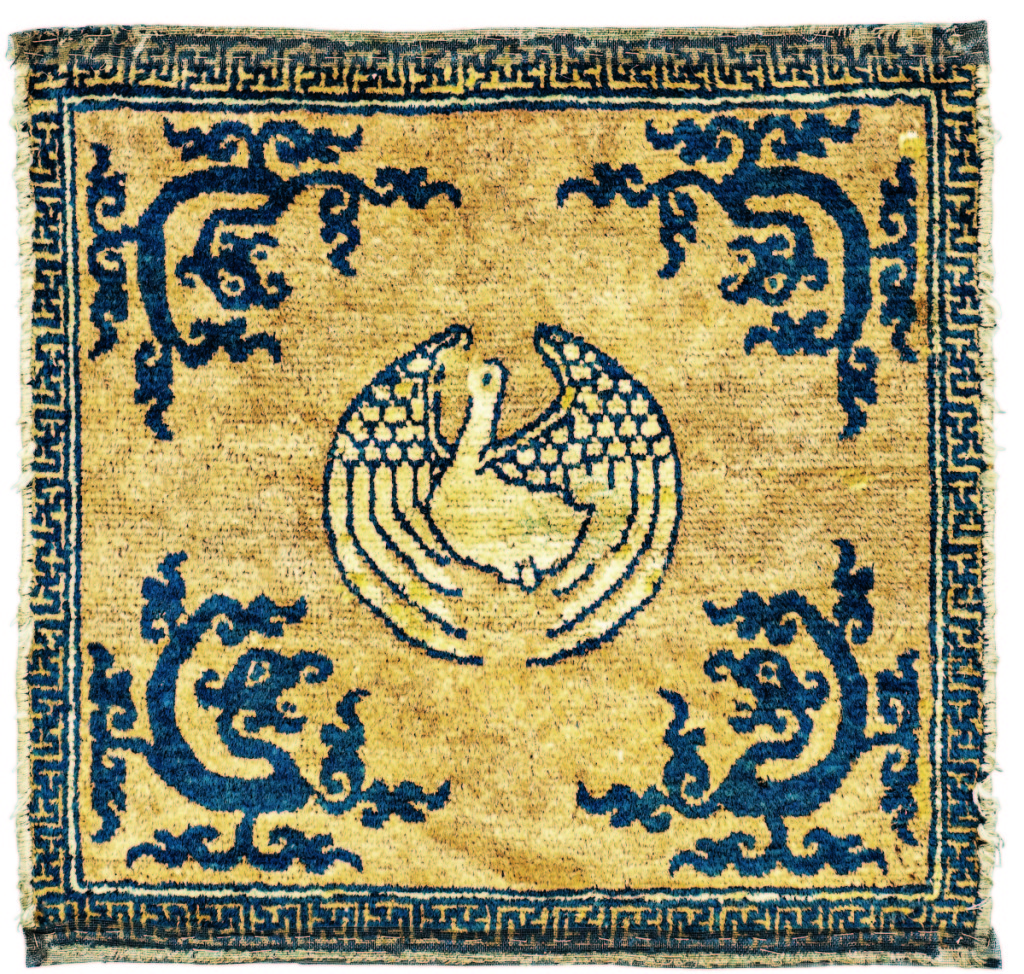
The Kangxi mat from western China, circa 1700, was the top highlight of the Ronnie Newman collection. Measuring 2 feet 4 inches by 2 feet 5 inches, it sold for $22,140.
Review by W.A. Demers
MARLBOROUGH, MASS. – Skinner’s December 9 auction included the second part of the Ronnie Newman collection of early Oriental rugs. Also offered were more than 150 rugs of widely varied ages, sizes and origins consigned by other collectors. The overall sale comprised about 300 lots. Pieces from the Newman collection had also highlighted Skinner’s October Oriental rugs and carpets auction, where rare Seventeenth and Eighteenth Century rugs and mats attracted vigorous bidding and achieved excellent results.
The most recent auction was “a terrific sale,” according to Skinner’s director of Oriental rugs and carpets Lawrence Kearney. “Older Chinese rugs in good condition were the stars of both sales – ‘older’ meaning Eighteenth/early Nineteenth Century,” Kearney explained. “This is a recognition of Ronnie’s achievements as a collector, and also both sales presented a rare opportunity to purchase from a first-class collection of very old Chinese rugs formed over a 40-year period. “
The idea to spread the gems from Newman’s four decades of collecting over two sales, according to Kearney, was to properly showcase Newman’s pieces, known for their beauty, rarity and status as works of art. “I didn’t want to flood the market,” said Kearney.
Newman focused on four general areas. He was most passionate about early Chinese rugs, primarily made in western China for use in Tibetan monasteries; flatweaves and embroideries from northwestern Persia; early Turkoman carpets and other textiles; and early Anatolian rugs and kilims. In addition to their beauty and rarity, many of Newman’s pieces are distinguished by their small size – bags, bag faces and mats that have an intimate presence and invite prolonged, close-up appreciation.
Notably, six of the top ten lots in the December 9 sale were Chinese examples, and the top selling piece was a Kangxi mat from western China, circa 1700, which brought $22,140. With their subtle coloration, iconography and sumptuous materials, these Chinese mats, chair covers and saddle rugs were the ones that most engaged Newman’s eye. Age, too, played an important role, not just in the chronological sense but because, according to Kearney, the early rugs were more “pure” in design and fabrication, less susceptible to market forces. The many early pieces in the Newman collection are an important contribution to that collecting niche.
One of the highlights of the second half of the Ronnie Newman collection of rare early rugs was a fragment of a Sixteenth Century Anatolian rug, 2 feet by 3 feet, that was bid to $17,220. For certain things, size is an important factor,” said Skinner’s specialist. “In terms of collectability, it’s got to be size that you can put on the wall. With bag faces, smaller rugs and fragments, you can put them on your wall.”

Fetching $19,680 was this Dragon saddle rug, western China, circa 1800, 4 feet 6 inches by 2 feet 3 inches.
Newman made many memorable observations about the textiles he loved so passionately and studied so deeply. “Ronnie said to me, ‘There only three things one needs to know about rugs: color, color, color.’ So the first thing he would look for was beautiful color, not synthetic dyes and good wool quality, because wool quality affects how the color is absorbed, said Kearney.
In addition to the Chinese and early Anatolian examples, the Newman collection boasted a number of striking rugs from Persia (modern day Iran), such as an antique Fereghan Sarouk carpet, from western Iran, circa 1900. Measuring 21 feet 6 inches by 14 feet 1 inch, the carpet went out at $11,685.
Because early Chinese culture was equestrian, many of its older textiles turn out to be saddle rugs. In this sale, a Dragon saddle rug, circa 1800, 4 feet 6 inches by 2 feet 3 inches, brought the second highest price – $19,680 – and the top lot in Skinner’s October 21, 2018, sale was also a Chinese saddle rug, a silk example from the Seventeenth/Eighteenth Century, which sold for $39,360.
An interesting fact about saddle rugs, said Kearney, is that because they hung down on both sides of the horse, they were always made in two parts so that the pile could run down on both sides – ensuring that in a rain storm, the water would run downward as well.
The final ingredient in Newman’s collecting rubric might well be whimsy. When asked why the Kangxi mat did so well, Kearney pointed out that most iconography in these pieces was usually of the foliate-dragon variety – a combination of vines and dragons – explained the specialist. “Here, the central figure is a phoenix or maybe it’s a crane – at any rate, it’s a bird. Rare – and collectors like rarity.”
Prices given include the buyer’s premium as stated by the auction house.
Skinner’s next high-end Oriental rug sale is slated for April 28 and will include about 150 pieces from a single-owner collection. For information, 508-970-3247 or www.skinnerinc.com.













